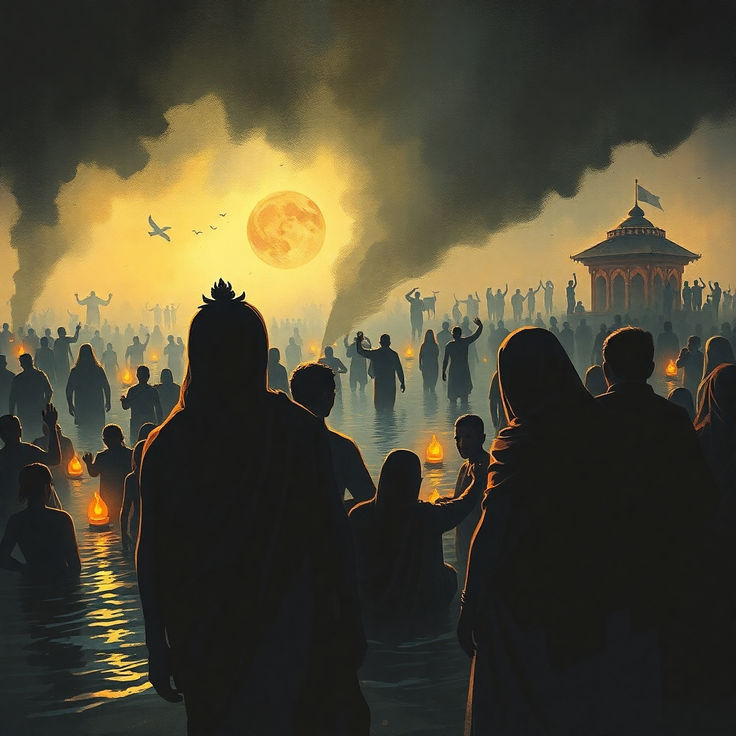The Tragic Maha Kumbh Mela Stampede: History, Impact, and Lessons Learned
Maha Kumbh Mela Stampedes: Maha Kumbh Mela is one of the largest religious gatherings in the world, attracting millions of devotees who come to take a holy dip in the sacred rivers of India. However, amidst the spiritual significance and grandeur, history has also witnessed tragic stampedes that have resulted in significant loss of lives. This article delves into the history, causes, impact, and essential lessons from Maha Kumbh Mela stampedes, along with its broader significance in society.
History of Maha Kumbh Mela Stampedes
Maha Kumbh Mela, held every 12 years at one of four sacred locations (Prayagraj, Haridwar, Ujjain, and Nashik), is deeply rooted in Hindu mythology. It is believed to be the time when the celestial alignment purifies the waters, making it the most auspicious occasion for spiritual cleansing.
Unfortunately, due to the massive influx of people, stampedes have occurred multiple times, leading to tragic incidents. Some of the deadliest stampedes in Maha Kumbh Mela history include:
- 1954 Prayagraj Stampede – Over 800 people lost their lives due to overcrowding.
- 2003 Nashik Stampede – Nearly 40 devotees perished in a tragic crush.
- 2013 Allahabad Railway Station Stampede – Around 36 people died due to a rush at the station during the peak of the festival.
Significance of Maha Kumbh Mela Stampedes
Despite the tragic incidents, Maha Kumbh Mela remains a significant cultural and religious event:
- Spiritual Importance: Devotees believe that bathing in the sacred river during Kumbh Mela washes away sins and grants liberation (moksha).
- Economic Impact: The event generates massive revenue for local businesses, tourism, and vendors.
- Cultural Exchange: It attracts visitors from around the world, promoting interfaith harmony and cultural heritage.
- Religious Gatherings: It provides a platform for saints, seers, and religious leaders to impart wisdom and teachings.
Impact on Daily Life and Society: Maha Kumbh Mela Stampedes
- Transportation Challenges: Due to the large crowd, roads, railway stations, and airports become extremely congested, causing delays and disruptions.
- Public Safety Concerns: Stampedes, theft, and medical emergencies pose significant risks for attendees and security forces.
- Economic Boost: Small businesses, hotels, and vendors benefit from the massive influx of pilgrims and tourists.
- Civic and Infrastructure Strain: Managing sanitation, healthcare, and traffic control becomes a herculean task for authorities.
Major Causes of Maha Kumbh Mela Stampedes
Several factors contribute to tragic stampedes at Kumbh Mela, including:
- Overcrowding due to millions of devotees gathering at limited spaces.
- Lack of Proper Crowd Management causing panic and chaos.
- Structural Failures like collapsed bridges or narrow pathways leading to suffocation and trampling.
- Sudden Surges in Crowd Movement due to rumors, fear, or religious fervor.
Preventive Measures and Lessons Learned
Authorities have implemented several measures to prevent future stampedes, including:
- Advanced Crowd Monitoring: Use of drones, CCTV surveillance, and AI-powered analytics.
- Designated Entry and Exit Points: To prevent bottlenecks and allow smoother movement.
- Increased Security Deployment: More police personnel and volunteers are stationed at critical points.
- Public Awareness Campaigns: Educating pilgrims on safety measures and emergency protocols.
10 Important Facts About Maha Kumbh Mela and Stampedes
- Maha Kumbh Mela is the largest religious gathering in the world.
- It is estimated that over 100 million people attend in a single festival.
- The event is held at four rotating locations in India.
- The 1954 stampede was one of the worst, with over 800 fatalities.
- In 2013, an Allahabad railway station stampede caused the death of 36 people.
- Authorities now use RFID tracking for pilgrims to manage crowd movements.
- The event contributes billions of dollars to the economy.
- It is recognized as an Intangible Cultural Heritage by UNESCO.
- The festival dates are determined by astrological alignments.
- The event sees participation from sadhus, saints, and devotees from around the world.
FAQs About Maha Kumbh Mela and Stampedes
1. What is the Maha Kumbh Mela?
Maha Kumbh Mela is a massive Hindu pilgrimage that takes place every 12 years at one of four locations in India, attracting millions of devotees.
2. Why do stampedes happen at Kumbh Mela?
Stampedes occur mainly due to overcrowding, poor crowd management, and structural failures in high-density areas.
3. How is the government preventing future stampedes?
Measures like real-time surveillance, strict crowd control, improved infrastructure, and digital tracking are being implemented.
4. What are some safety tips for attendees?
- Follow designated paths and avoid overcrowded areas.
- Stay updated on emergency exit points.
- Travel with companions and avoid panic in large gatherings.
5. Why is Maha Kumbh Mela important to society?
Beyond its religious significance, Kumbh Mela fosters economic growth, cultural exchange, and social unity.
Conclusion: A Sacred Festival with Critical Lessons
Maha Kumbh Mela Stampedes: Maha Kumbh Mela is a profound spiritual gathering that unites millions in faith and devotion. However, the tragic stampedes serve as a reminder of the importance of effective crowd management, infrastructure development, and public awareness. While the festival continues to inspire and uplift society, lessons from past tragedies must shape a safer and more organized future for all attendees.
The Maha Kumbh Mela is one of the largest religious gatherings in the world, held every 12 years in India at one of four locations: Prayagraj, Haridwar, Ujjain, and Nashik. While the event is deeply spiritual, it has also witnessed tragic stampedes due to massive crowds, inadequate crowd management, and panic situations.
- 2013 Prayagraj Stampede
- Date: February 10, 2013
- Location: Allahabad Railway Station
- Casualties: Over 36 dead, 39+ injured
- Cause: Overcrowding at the railway station as millions of pilgrims arrived for the auspicious Mauni Amavasya bathing day. A footbridge collapsed due to the pressure, triggering a panic-driven stampede.
- 2003 Nashik Stampede
- Date: August 27, 2003
- Casualties: 39 dead, 125+ injured
- Cause: A sudden rush near the Ramkund bathing area led to people getting trampled and suffocated.
- 1954 Prayagraj Stampede
- Date: February 3, 1954
- Casualties: Over 800 dead, thousands injured (largest recorded Kumbh Mela disaster)
- Cause: Poor crowd control and temporary bridges collapsing under pressure caused chaos among the millions of devotees.
- Overcrowding: Tens of millions of devotees gather at a single location.
- Poor Infrastructure: Temporary bridges and narrow pathways often cannot handle the crowd surge.
- Panic Situations: Rumors, sudden movements, or accidents can cause mass hysteria.
- Lack of Crowd Management: Insufficient police and security personnel to guide devotees effectively.
- Better Infrastructure: Stronger bridges, wider pathways, and designated crowd zones.
- Technology Use: Drone surveillance, AI-based crowd monitoring, and emergency alert systems.
- Improved Crowd Control: More security personnel, barricades, and staggered entry timing for pilgrims.
- Public Awareness: Educating visitors on safety protocols and emergency exits.
While Maha Kumbh Mela remains a remarkable cultural and spiritual event, ensuring safety measures and effective crowd management is crucial to prevent tragedies in the future.










